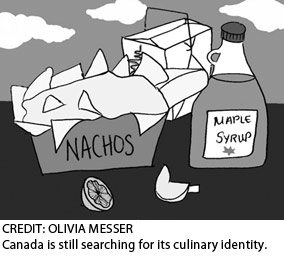Canadian cuisine more than maple syrup and poutine

MONTREAL (CUP) — In the mind of most people, the words Canadian and cuisine don't go together.
Other countries, like France and Italy, have internationally recognized menus whose popularity has crossed borders. Even Quebec has developed its own hearty cuisine, with poutine beginning to appear across the U.S. The closest thing to a distinctly Canadian culinary staple comes in a large paper cup from Tim Hortons.
Nathalie Cooke, a professor at McGill University, has some background in the matter. She is the founding editor of CuiZine: the Journal of Canadian Food Cultures, and, most recently, editor of What's to Eat: Entr�es in Canadian Food History, which was shortlisted for the 2010 Cuisine Canada Book Awards.
In an email, she explained the problem with trying to determine Canadian food identity.
"Certainly, the notion of a singular Canadian culture is problematic ... With a multicultural population that includes successive waves of immigrants from around the world, in addition to descendants of the land's First Nations, scepticism about a singular culinary culture is understandable."
Margaret Webb, a writer and teacher at Toronto's Ryerson University, echoed Cooke's explanation that a particular food identity in Canada is difficult to pinpoint.
"Because Canada is so large, it's very difficult to have a national food identity," she said.
She is hopeful, however, that this will change, mentioning that aside from an initial step to produce tastier food regionally, Canada also has great ethnic diversity.
"When you bring people from all over the world and ... when these folks bring their food inclinations to Canada, and you marry that with great, local, diverse food, then you get this food culture that starts to be pretty uniquely Canadian."
Webb is author of the recent Apples to Oysters: A Food Lover's Tour of Canadian Farms, which raises awareness of the benefits of local and sustainable farming in Canada. The book profiles one farmer from each province and the Yukon who grow an iconic Canadian food in a sustainable setting.
Webb described the book's criteria as farmers that "had to be producing a food for quality and taste, not just ... a big production farm ... and environmental sustainability."
Canadian food identity is mired in stereotypes, not all of which are unjustified, said Cooke.
"Maple syrup is synonymous with Canadian foodways, in part because Canada is one of the only places, besides the northeast United States, with climatic conditions conducive to its production. Quebec remains the world's primary maple syrup producer."
But Webb is hoping to raise awareness for Canadians to create a lasting food identity for themselves.
"Canadians have grown too disconnected from our food systems, so I wanted to give them a sense of ... where does our food come from, how is it grown, and what are the challenges these farmers are facing? Why is environmentally-sustainable food better tasting and better for the environment than all this industrial crap that we're getting?"
When food is produced locally, organically and sustainably, it starts to take on a flavour of its own. To Webb, this means that local food is a necessary foundation for a distinct national cuisine.
"You're raising animals, livestock properly, you know, on pasture, grass," Webb explained. "If you're growing food organically, you're really working with the soil that's in your particular region to create food that tastes of that soil and of that region, and you start to work with the natural advantages of that region ... Regional food identity all depends on sustainability."
Despite the nation's abundant natural resources, most of it is not being used in a sustainable or profitable way. The discrepancy lies partly in a lack of motivation, Webb explained.
"The one thing we lack, of course, is strong support and appreciation for good farming in this country, and a strong appreciation and support for quality ingredients ... We have incredible opportunity but we ... don't have a deep enough food culture."
Another problem is the uninformed market.
"Half of the best farmland in Canada, which is in Ontario, is devoted to corn and soybeans. It makes no sense. Most of us didn't eat corn and soybeans for dinner last night, did we? Yet we did. It's in all our food. It's in our cattle, it feeds all of our livestock. It's in all of our processed food. Essentially, if you have an industrial farm system, you have no food identity."
Not only is Canada's current agricultural system nutritionally detrimental, it is economically illogical, too.
"We're producing these really, really cheap crops and farmers don't make a lot of money from it, and then we export them and we're not getting value out of them. Ontario ... is importing half of its food and it's the food we're actually eating. We really have to get back to feeding ourselves."
Webb said that a growing movement toward local and sustainable agriculture is trumped by a lofty proportion of agriculture.
"Canada kind of has to make a decision which way we're going to go with this, 'cause the five per cent (of sustainable, organic food production) could be crushed like a bug tomorrow," she said.
It's the mixture of materials and preparation methods that will shape a Canadian food identity.
"In Canada we have these fantastic ingredients. There are few countries in the world that have more potential than Canada to produce amazing food. And then you marry that with all the incredible ethnic diversity coming into our country, who are (sic) going to bring all these food styles with them."
Webb mentioned Ukrainian immigration to the Prairies as an influence on the region's cuisine - "Ukrainian meets prairie buffalo equals bison pierogies."
Although fusion cuisine is not a uniquely Canadian concept, it can be a good starting point for the development of a national food identity.













